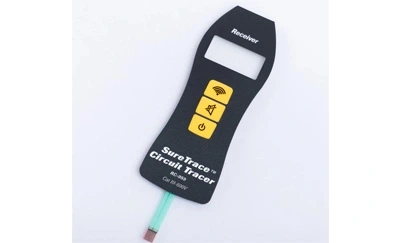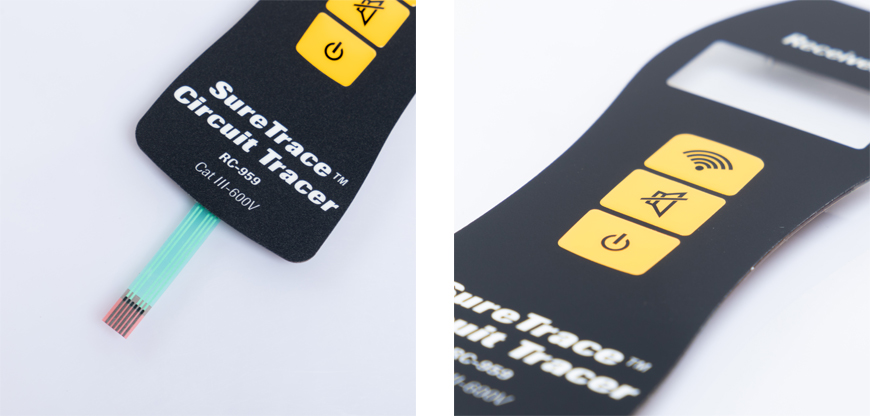
In the fast-paced world of technology, our daily interactions with electronic devices often revolve around keyboards. These ubiquitous input devices come in various forms, but one that stands out for its durability, tactile feedback, and widespread use is the "Dome Switch Membrane" keyboard. In this article, we will dive deep into the world of dome switch membrane keyboards, exploring their construction, functionality, advantages, and applications.

1. Introduction to Dome Switch Membrane Keyboards
2. The Anatomy of a Dome Switch Membrane Keyboard
· Top Layer: Keycaps
· Middle Layer: Membrane Layer
· Bottom Layer: PCB (Printed Circuit Board)
3. How Do Dome Switch Membrane Keyboards Work?
4. Advantages of Dome Switch Membrane Keyboards
· Durability and Longevity
· Tactile Feedback
· Quiet Operation
5. Applications of Dome Switch Membrane Keyboards
· Computer Keyboards
· Remote Controls
· Industrial Control Panels
6. Dome Switch Membrane vs. Mechanical Keyboards
· Typing Experience
· Noise Levels
· Cost
7. Maintenance and Cleaning Tips
8. Future Developments in Dome Switch Membrane Technology
9. Conclusion
10. FAQs
Dome switch membrane keyboards are a type of input device commonly found in a wide range of electronic devices. These keyboards are known for their reliability and user-friendly design. Unlike traditional mechanical keyboards, dome switch membrane keyboards use a different mechanism for registering keystrokes.
To understand how dome switch membrane keyboards work, let's break down their components:
Top Layer: Keycaps
The top layer of a dome switch membrane keyboard consists of keycaps. These are the visible parts of the keyboard that users press to input characters. Keycaps are typically made from materials like ABS plastic and are designed to provide a comfortable typing experience.
Middle Layer: Membrane Layer
Beneath the keycaps lies the membrane layer, which is a crucial part of the keyboard's design. This layer contains domes made of silicone rubber, which serve as the tactile switches. When a key is pressed, the dome collapses, creating an electrical connection that registers the keystroke.
Bottom Layer: PCB (Printed Circuit Board)
The bottom layer of the keyboard is the PCB or Printed Circuit Board. This layer houses the electrical circuits that connect to the membrane layer. When a key is pressed and the dome collapses, it completes the circuit, sending a signal to the device to register the keypress.
Dome switch membrane keyboards work based on the principle of capacitive sensing. When you press a key, it pushes down on the silicone dome, causing it to collapse and create a connection between two conductive layers on the PCB. This connection registers the keypress, and the corresponding character appears on the screen.
Durability and Longevity
One of the standout features of dome switch membrane keyboards is their durability. The silicone domes are built to withstand millions of keypresses, making these keyboards an excellent choice for long-term use.
Tactile Feedback
Dome switch membrane keyboards offer a tactile feedback that many users find satisfying. The slight resistance and soft feel when pressing keys enhance the typing experience.
Quiet Operation
Unlike some mechanical keyboards that can be noisy, dome switch membrane keyboards operate quietly, making them ideal for shared workspaces or quiet environments.
Dome switch membrane keyboards find applications in various devices and industries:
Computer Keyboards
Dome switch membrane keyboards are commonly used in computer keyboards, offering a comfortable typing experience for users.
Remote Controls
Many remote controls for televisions, home theaters, and other electronic devices use dome switch membrane technology for responsive and quiet button presses.
Industrial Control Panels
In industrial settings, dome switch membrane keyboards are preferred for their durability and resistance to harsh conditions.
Typing Experience
While dome switch membrane keyboards provide a soft and quiet typing experience, mechanical keyboards offer a more tactile and audible response.
Noise Levels
Mechanical keyboards can be noisy due to the audible click of each keypress, whereas dome switch membrane keyboards operate quietly.
Cost
Dome switch membrane keyboards are often more affordable than mechanical keyboards, making them a budget-friendly choice for many users.
To ensure the longevity of your dome switch membrane keyboard, follow these maintenance and cleaning tips:
· Regularly clean the keycaps with a damp cloth.
· Avoid spilling liquids on the keyboard.
· Use a can of compressed air to remove dust and debris from between the keys.
As technology continues to advance, we can expect further improvements in dome switch membrane technology. These keyboards will likely become even more durable, responsive, and versatile in the years to come.
Dome switch membrane keyboards have earned their place in the world of input devices, offering durability, tactile feedback, and quiet operation. Whether you're typing up a document, controlling your TV, or operating industrial machinery, these keyboards provide a reliable and comfortable experience.
Are dome switch membrane keyboards better than mechanical keyboards?
Dome switch membrane keyboards are quieter and more affordable, making them a preferred choice for some users. However, the preference between the two depends on individual typing preferences.
Can dome switch membrane keyboards be customized with backlighting?
Yes, many dome switch membrane keyboards come with customizable backlighting options, allowing users to choose their preferred lighting effects.
Are dome switch membrane keyboards easy to clean?
Dome switch membrane keyboards are relatively easy to clean. Regular maintenance involves cleaning the keycaps and removing dust and debris from between the keys.
Do dome switch membrane keyboards have a limited lifespan?
Dome switch membrane keyboards are designed to be durable and can withstand millions of keypresses, ensuring a long lifespan.
Can I use a dome switch membrane keyboard for gaming?
While dome switch membrane keyboards are not as popular in gaming as mechanical keyboards, they can still be used for gaming, especially if you prefer a quieter and softer keystroke experience.